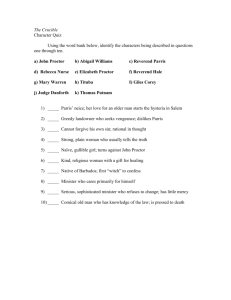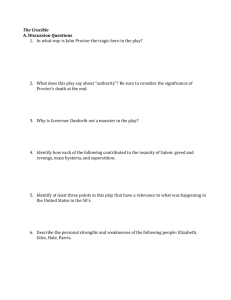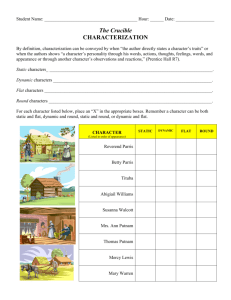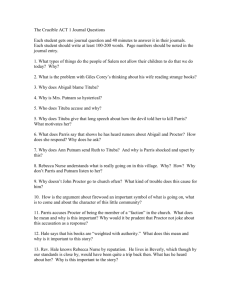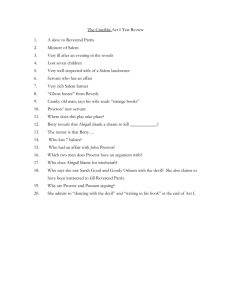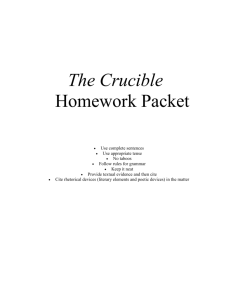Name Block The Crucible by Arthur Miller Act One The Exposition
advertisement
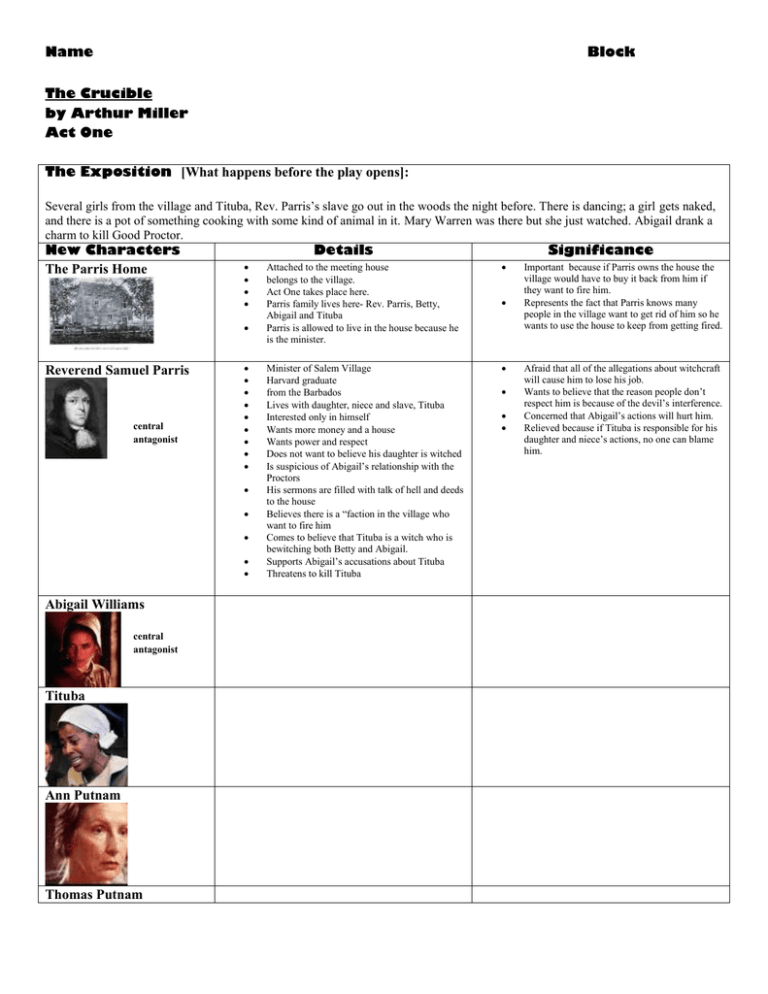
Name Block The Crucible by Arthur Miller Act One The Exposition [What happens before the play opens]: Several girls from the village and Tituba, Rev. Parris’s slave go out in the woods the night before. There is dancing; a girl gets naked, and there is a pot of something cooking with some kind of animal in it. Mary Warren was there but she just watched. Abigail drank a charm to kill Good Proctor. New Characters The Parris Home Details Reverend Samuel Parris central antagonist Abigail Williams central antagonist Tituba Ann Putnam Thomas Putnam Significance Attached to the meeting house belongs to the village. Act One takes place here. Parris family lives here- Rev. Parris, Betty, Abigail and Tituba Parris is allowed to live in the house because he is the minister. Minister of Salem Village Harvard graduate from the Barbados Lives with daughter, niece and slave, Tituba Interested only in himself Wants more money and a house Wants power and respect Does not want to believe his daughter is witched Is suspicious of Abigail’s relationship with the Proctors His sermons are filled with talk of hell and deeds to the house Believes there is a “faction in the village who want to fire him Comes to believe that Tituba is a witch who is bewitching both Betty and Abigail. Supports Abigail’s accusations about Tituba Threatens to kill Tituba Important because if Parris owns the house the village would have to buy it back from him if they want to fire him. Represents the fact that Parris knows many people in the village want to get rid of him so he wants to use the house to keep from getting fired. Afraid that all of the allegations about witchcraft will cause him to lose his job. Wants to believe that the reason people don’t respect him is because of the devil’s interference. Concerned that Abigail’s actions will hurt him. Relieved because if Tituba is responsible for his daughter and niece’s actions, no one can blame him. Details Significance Mercy Lewis Mary Warren Betty Parris John Proctor central protagonist Giles Corey Rebecca Nurse Reverend John Hale Additional Notes and Important Information: Pay particular attention to each character’s position on the existence of witchcraft in Salem and his or her motives behind that position. The Crucible by Arthur Miller Act Two What has happened between the end of Act One and the beginning of Act Two? Setting The Proctor Home Details Significance [pay attention to the atmosphere as well as the physical details] New Characters Elizabeth Proctor Francis Nurse Ezekiel Cheever Marshall Herrick Examples of external conflict thus far in the play – Examples of internal conflict thus far in the play – Look at the arguments between Reverend Hale and the Proctors during Hale’s questioning. What logical and emotional claims do the Proctors offer to support their behavior? The Crucible by Arthur Miller Act Three What has happened between the end of Act Two and the beginning of Act Three? Setting The Salem Meeting House Details Significance [Look at the stage direction description for key details that suggest mood] New Characters Judge Hathorne Deputy Governor Danforth [Pay particular attention to the motives behind Gov. Danforth’s decisions,] central antagonist The Husbands’ Defense Plan A – Plan B – Plan C – Plan D – [DEFCON 5!!!] Explain Elizabeth Proctor’s answer to Governor Danforth when asked if her husband is a lecher. Explain Reverend Hale’s response to Elizabeth’s answer. The Crucible by Arthur Miller Act Four What has happened between the end of Act Three and the beginning of Act Four? Setting The Salem Jail Details New Character Sarah Good Significance [What is the purpose of this scene with Sarah Good and Tituba?] John Proctor’s Moral Dilemma – In the space below, outline the process John undergoes to reach his final decision. A dynamic character is one who undergoes change throughout a work. Identify at least three dynamic characters in The Crucible and explain the changes you see in their characters. Examine the following definitions of the word “crucible” according to Merriam-Webster online. Explain Miller’s title using examples from the characters’ experiences in the play. 1 : a vessel of a very refractory material (as porcelain) used for melting and calcining a substance that requires a high degree of heat 2 : a severe test 3 : a place or situation in which concentrated forces interact to cause or influence change or development
